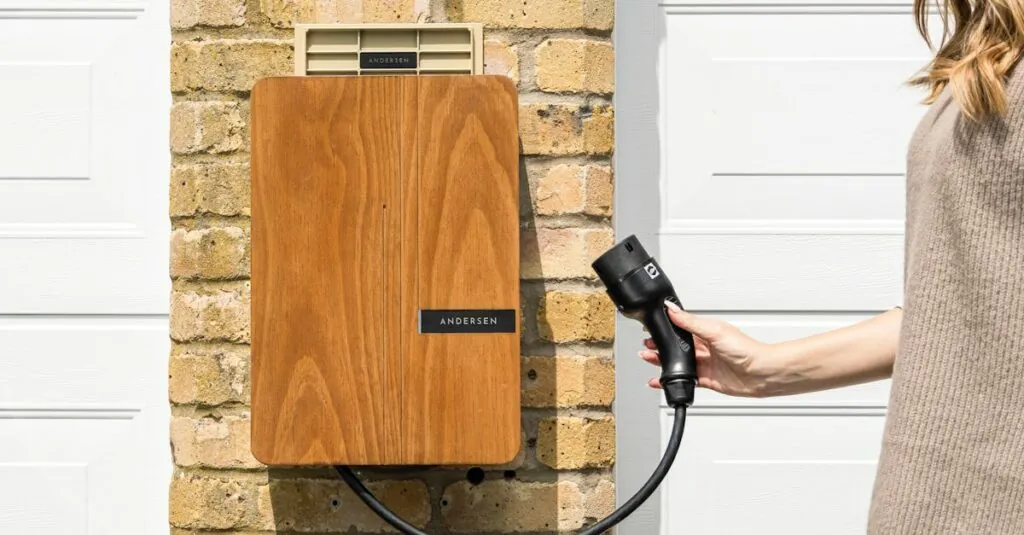As electric vehicles zoom into the mainstream, the need for a home charging station has never been more critical. Imagine rolling out of bed, sipping your morning coffee, and knowing your car’s already charged and ready to hit the road. No more waiting in line at crowded charging stations or playing the “Will it make it?” game on long trips. Installing an EV charger at home is not just a convenience; it’s a game-changer.
Table of Contents
ToggleUnderstanding EV Chargers
Understanding the landscape of EV chargers is essential for any electric vehicle owner. It involves recognizing various types of chargers and the benefits they bring.
Types of EV Chargers
Three main types of EV chargers exist: Level 1, Level 2, and DC Fast Chargers. Level 1 chargers use a standard 120-volt outlet, offering a slow charge that adds about 2 to 5 miles of range per hour. Level 2 chargers operate on 240 volts, providing a quicker charge that adds approximately 10 to 60 miles of range per hour. DC Fast Chargers deliver rapid charging, often replenishing 80% of an EV’s battery in about 30 minutes. Each type serves different needs based on charging speed and installation requirements.
Benefits of Installing an EV Charger at Home
Installing an EV charger at home offers several advantages. Convenience ranks high, as home charging eliminates the need for frequent trips to public stations. Cost savings become evident when considering longer-term charging expenses. Time savings occur as drivers can begin each day with a full battery. Enhanced property value might result from having a home charging station, appealing to potential buyers. Additionally, homeowners can take advantage of off-peak electricity rates, further reducing costs.
Preparing for Installation
Preparing for the installation of an EV charger requires careful planning and consideration. Several key aspects come into play to ensure a successful setup.
Assessing Your Electrical System
Evaluating the existing electrical system is crucial. This assessment helps determine if it can support the new charger. A 240-volt circuit is typically required for Level 2 chargers, so checking the capacity of the panel is essential. Electricians often recommend assessing available amperage, as many homes may need upgrades to accommodate the additional load. Identifying any potential issues beforehand can prevent complications down the road.
Choosing the Right Location
Selecting an optimal location for the charger enhances convenience. Positioning the charger close to the parking area of the EV minimizes cable length and reduces trip hazards. Consider accessibility when choosing the spot; the charger should be easy to plug in without strain. Proximity to your electrical panel also matters, as shorter cable runs can lower installation costs. Ensure the location complies with codes and safety regulations for a secure setup.
Installation Process
The installation of an EV charger at home involves specific tools, materials, and a clear step-by-step approach.
Required Tools and Materials
Gather essential tools and materials before starting the installation. Tools include a drill, screwdrivers, wire strippers, and pliers. Materials consist of a mounting bracket, electrical cable, circuit breaker, and the EV charger itself. Ensure to have safety equipment like gloves and goggles for protection. A stud finder can help locate suitable mounting locations. Prior preparation saves time and reduces potential complications during installation.
Step-by-Step Installation Guide
Begin the installation by turning off the power at the main electrical panel. Mark the installation location near the vehicle parking area for easier access. Next, install the mounting bracket securely to the wall. Run the electrical cable from the panel to the charger location, ensuring proper gauge and amperage ratings. Connect the wires to the circuit breaker and charger following manufacturer instructions. Testing the charger after installation confirms functionality. Finally, restore power to the circuit and check for proper operation before using the charger.
Safety Considerations
Safety plays a critical role during the installation of an EV charger at home. Proper precautions ensure a successful and hazard-free setup.
Electrical Safety Tips
Ensure proper circuit compatibility before installation. Check that the existing electrical system supports the required voltage and amperage. Use high-quality cables designed for electric vehicle chargers to avoid overheating. Secure all connections tightly to prevent loose wiring. Wear protective gear like gloves and goggles while handling electrical components. Always turn off the power at the main electrical panel before starting the installation. Test the charger after installation to confirm functionality and check for overheating or unusual sounds.
Compliance with Local Regulations
Understand local electrical codes before starting the installation. Each jurisdiction may have specific requirements that dictate installation practices. Some areas might require permits for electrical work, especially for high-powered chargers. Qualified electricians are familiar with these regulations and can ensure compliance. Accurate documentation might be necessary for inspections after installation. Familiarity with local utility company guidelines could also provide insight into available incentives for home EV charger installation.
Maintaining Your EV Charger
Maintaining your EV charger ensures optimal performance and longevity. Regular care helps prevent potential issues and keeps charging effortless.
Routine Maintenance Tasks
Check the charger for any signs of wear and tear. Clean the unit regularly to remove dirt or debris that might affect functionality. Inspect cables for fraying or damage to ensure safe operation. Test the circuit breaker monthly to confirm it remains operational. Monitor for unusual sounds or smells during operation, as these can indicate issues. Keeping the area around the charger clear enhances accessibility and safety.
Troubleshooting Common Issues
Address charging failures by first checking the power source. If the charger isn’t responding, inspect the circuit breaker for tripped switches. Verify that the vehicle is correctly connected to the charger for optimal performance. Look for error codes on the charger’s display and consult the manufacturer’s manual for guidance. Utilize local support services for persistent problems or considering a technician’s help for complex issues. Fast responses help maintain reliable charging capabilities.
Installing an EV charger at home is a smart investment that enhances convenience and efficiency for electric vehicle owners. By understanding the different charger types and following proper installation procedures, individuals can create a reliable charging solution that fits their lifestyle.
With careful planning and attention to safety, the process can be straightforward and rewarding. Regular maintenance ensures the charger remains in top condition, providing peace of mind and optimal performance.
As electric vehicles continue to gain popularity, having a home charging station not only benefits the owner but also contributes to a more sustainable future. Embracing this technology can lead to significant savings and a hassle-free driving experience.





